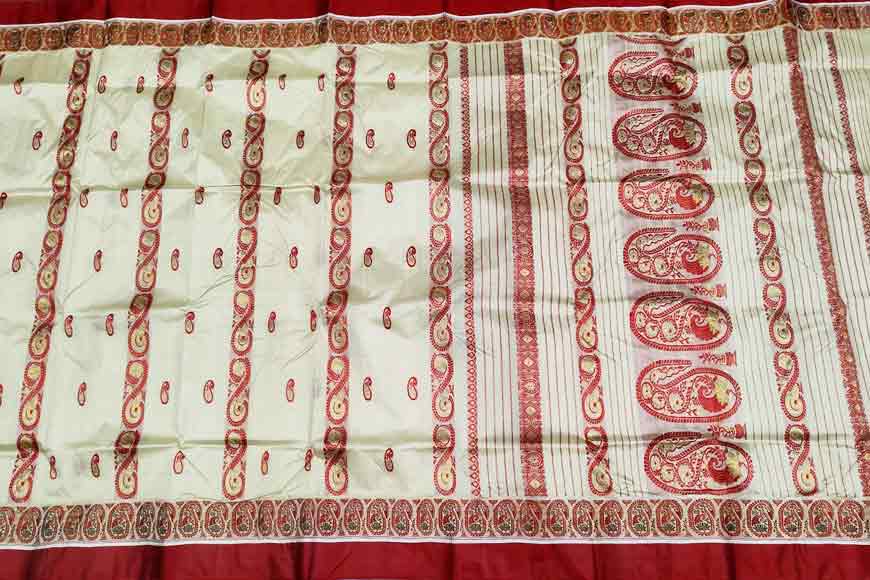Five products from Bengal get the prestigious GI tags – GetBengal story

West Bengal witnesses the recognition of five indigenous products with geographical indication (GI) tags.
This is a significant step in preserving and promoting its rich cultural and agricultural heritage and acknowledges its unique qualities as well as origins of them, hereby assuring legal protection and increasing their market value. This was a long due expectation and is certainly a proud moment for Bengal and thousands of farmers and artisans, giving a stamp of authenticity to their products.
The five goods that have been granted GI tags are natural honey from Sunderban- a World Heritage site declared by the UNESCO, Kalo Nunia rice from Jalpaiguri, Murshidabad's Garad and Korial sarees, along with Tangail sarees of Nadia and East Burdwan. This inclusion in the list of GI-tagged products in West Bengal only reinforces the diverse cultural tapestry and rich agricultural landscape of the state.
 Moule of Bengal collects the honey from the Sundarbans
Moule of Bengal collects the honey from the Sundarbans
The Moule of Bengal collects the honey from the Sundarbans under the supervision of the West Bengal Forest Development Corporation and is known as “Mouban”. This natural honey is from the forests of the Sundarbans Biosphere Reserve, where approximately 2,000 residents, known as Mauli, sustain their livelihood through honey collection. They are sourced primarily from the nectar of Sundarbans mangrove trees like Sundari, Garan, Khalisa, and Geoa and have a typical woody aroma and flavour compared to lighter honeys. This recognition of Sundarbans honey celebrates the sustainable practices of the Mauli community and also promotes the conservation of this crucial ecosystem. But there is also a concern among small honey procurers like Tanmay Mandal, “The impoverished gather honey, which I then procure from them and sell to potential customers. I provide the honey collectors, known as Mouli, with the price I receive for the honey, and they, in turn, give me a certain percentage as I function as the intermediary. By doing so, they receive a fair price, often more than what other sellers offer, leading them to willingly supply honey to me. Unfortunately, this is not the case when they need to sell to bigger organisations when officials purchase honey directly from them. They often do not receive a proper and fair price.”
Also read : Wow! Darjeeling’s Green and White Tea get GI tag
 Kalo Nunia rice from Jalpaiguri
Kalo Nunia rice from Jalpaiguri
Kalo Nunia rice from Jalpaiguri in North Bengal, has been popular for its exceptional quality and rarity. This indigenous rice variety, now protected under the GI tag, holds cultural and economic significance in the region. Kalonunia is an aromatic rice produced in North Bengal region of West Bengal. It has a nutty flavor and a unique aroma that is often described as being floral or pandan-like. The rice grains are small and slender, and they are non-glutinous, ie, they do not stick together when cooked. The GI recognition not only puts this variety on a pedestal but also is a testament to the farmer empowerment. The farming process without the use of chemicals and pesticides add to the purity quotient of this variety of rice.
 Garad sarees of Murshidabad district
Garad sarees of Murshidabad district
 Korial sarees of Murshidabad district
Korial sarees of Murshidabad district
The renowned Garad and Korial sarees of Murshidabad district also have been conferred the GI tag. Woven by skilled artisans in Mirjapur, Jiaganj, and Islampur, these sarees carry a legacy of craftsmanship and heritage. Crafted from pure, high-quality Tussar silk, known for its softness, strength, and subtle sheen, both require skilled craftsmanship and attention to the detailing. Weavers use traditional pit looms and the 'bala tana' technique helping to ceate a fine and even fabric. Weavers of Garad and Korial at Mirjapur, Jiaganj and Islampur in Murshidabad district have wholeheartedly welcomed the news of receiving the GI tag.
 Tangail sarees from Nadia
Tangail sarees from Nadia
Similarly Tangail sarees from Nadia, Bardhaman district of West Bengal have also been given the GI Tag. Tangail sarees are known for their intricate geometric and floral patterns woven directly into the fabric using extra weft threads. Originating from the Tangail region of undivided India, now in Bangladesh, this variety of saree came to India with the migration of the Basak family of Tangail who settled in Nadia and made it their home. There has been a hue and cry over the ownership of this Tangail variety and how legitimate it is for the Indian Government to confer this status to a product which has its origin in a different country.
However, GI tags have evoked mixed responses among its practitioners and tangail weavers are no exception.
Nilay Kumar Basak, who serves as a teacher at Santipur Muslim High School, a scholar researching on the weaving industry (tant shilpo) at Kala Bhavan, Vishwa Bharati, and is also the editor of the “Tana-Poren” magazine, told GB:“While the GI tag is undoubtedly an honourable recognition, there remain uncertainties regarding whether the producers of the sarees will genuinely benefit from it”
Inspite of all the concerns which could be genuine, the addition to the GI tag list of these five products will certainly give a boost to the producer community and time can only say whether these tags will be of any benefit to them.











